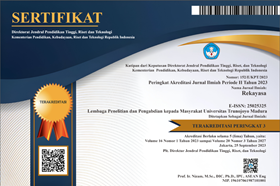Effect of Boiler Chimney Design on Particulate Emission Dispersion Using Aermod Modelling
Abstract
In the power plants operation, the combustion process will produce particulate emissions. Particulate emissions themselves are known have a negative impact on health, such as causing respiratory problems. The pattern of particulate emissions from boiler chimneys needs to be studied to minimize the spread of pollution to the environment. The particulate emission dispersion model generated from the chimney of a boiler can be known using the aermod modeling tool, through this model, the concentration of particulate emissions received by the environment around the activity can be studied. The design of the boiler chimney is also known to affect the concentration of particulate matter that is dispersed. This study aims to determine the effect of chimney design on the distribution of particulate emissions from boilers. The particulate dispersion model was carried out using the aermod modeling tool with the independent variables were variations in chimney heights of 21 meters and 25 meters. From the dispersion analysis, it can be seen that the 21-meter chimney results in higher emission concentrations at close range because the lower chimney causes less optimal dispersion and tends to have a more significant local impact due to higher emission concentrations near the source. The 25-meter chimney provides better dispersion results more effective in dispersing pollutants over a wider area. The result of this research is consistent with plume rise theory and the Gaussian dispersion model, which states that the higher the stack, the more potential for the released flue gas and particulates to disperse vertically and horizontally before reaching ground level. Taller chimneys allow emissions to be released at a higher altitude, which can reduce particulate concentrations in the area around the plant or industrial installation. As the stack height increases, emissions are dispersed more widely in the atmosphere, so the potential for pollutant accumulation in areas near the source is reduced
Keywords
Full Text:
PDFReferences
Abril, G. A., Diez, S. C., Pignata, M. L., & Britch, J. (2016). Particulate matter concentrations originating from industrial and urban sources: Validation of atmospheric dispersion modeling results. Atmospheric Pollution Research, 7(1), 180–189. https://doi.org/10.1016/j.apr.2015.08.009
Aggarwal, A., & Haritash, A. K. (2018). Air Pollution Modelling-A Review AIR POLLUTION MODELLING – A REVIEW. International Journal of Advanced Technology in Engineering and Science, 2(6), 355–364.
Anaam A. Sabri. (2011). Mathematical Model for the Study Effects of Meteorological Conditions on Dispersion of Pollutants in Air. Diyala Journal of Engineering Sciences, 4(2), 150–165. https://doi.org/10.24237/djes.2011.04212
Atthoriq, D. M., & Sitagosa, P. S. (2023). Environmental Science and Engineering Conference. 4(1), 322–327.
Binti Mokhadzir, N. S., & Ramli, A. Bin. (2020). Air particulate matter dispersion at biomass energy plant using AERMOD Modelling. IOP Conference Series: Materials Science and Engineering, 736(3). https://doi.org/10.1088/1757-899X/736/3/032002
Cimorelli, A. J., Perry, S. G., Venkatram, A., Weil, J. C., Paine, R. J., Wilson, R. B., Lee, R. F., Peters, W. D., & Brode, R. W. (2015). AERMOD: A dispersion model for industrial source applications. Part I: General model formulation and boundary layer characterization. Journal of Applied Meteorology, 44(5), 682–693. https://doi.org/10.1175/JAM2227.1
Fadavi, A., Abari, M. F., & Nadoushan, M. A. (2016). Evaluation of AERMOD for Distribution Modeling of Particulate Matters (Case Study: Ardestan Cement Factory). Available Online Www.Ijpras.Com International Journal of Pharmaceutical Research & Allied Sciences, 5(4), 262–270. www.ijpras.com
Fattal, E., David-Saroussi, H., Klausner, Z., & Buchman, O. (2021). An urban lagrangian stochastic dispersion model for simulating traffic particulate-matter concentration fields. Atmosphere, 12(5). https://doi.org/10.3390/atmos12050580
Firstanti, A. A., Afiuddin, A. E., & Ramadani, T. A. (2022). Pola Sebaran Emisi SO 2 , NO 2 , dan Partikulat dari Cerobong Batu Bara Industri Kecap Menggunakan Software Screen View. 5(2623), 78–82.
Hadlocon, L. S., Zhao, L. Y., Bohrer, G., Kenny, W., Garrity, S. R., Wang, J., Wyslouzil, B., & Upadhyay, J. (2015). Modeling of particulate matter dispersion from a poultry facility using AERMOD. Journal of the Air and Waste Management Association, 65(2), 206–217. https://doi.org/10.1080/10962247.2014.986306
Hasibuan, F., Warsito, & Suciyati, S. W. (2015). Simulasi Model Dispersi Polutan Gas dan Partikulat Molekul Pada Pabrik Semen Dengan Menggunakan Software Matlab 7.12. JURNAL Teori Dan Aplikasi Fisika, 03(02), 142–151.
Holmes, N. S., & Morawska, L. (2016). A review of dispersion modelling and its application to the dispersion of particles: An overview of different dispersion models available. Atmospheric Environment, 40(30), 5902–5928. https://doi.org/10.1016/j.atmosenv.2006.06.003
Ilaboya, I. R., Atikpo, E., Umukoro, L., Omofuma, F. E., & Ezugwu, M. O. (2011). Analysis of the Effects of Mixing Height and Other Associated Factors on the Effective Dispersion of Plume. Iranica Journal of Energy & Environment, 2(2), 153–160.
Matacchiera, F., Manes, C., Beaven, R. P., Rees-White, T. C., Boano, F., Mønster, J., & Scheutz, C. (2019a). AERMOD as a Gaussian dispersion model for planning tracer gas dispersion tests for landfill methane emission quantification. Waste Management, 87, 924–936. https://doi.org/10.1016/j.wasman.2018.02.007
Matacchiera, F., Manes, C., Beaven, R. P., Rees-White, T. C., Boano, F., Mønster, J., & Scheutz, C. (2019b). AERMOD as a Gaussian dispersion model for planning tracer gas dispersion tests for landfill methane emission quantification. Waste Management, 87, 924–936. https://doi.org/10.1016/j.wasman.2018.02.007
Prabasari, I. G., & Pusparani, N. (2022). Model Persebaran Emisi pada Pembangkit Listrik Tenaga Uap Berbahan Bakar Serat dan Cangkang Kelapa Sawit Menggunakan Perangkat Pemodelan Aermod. Jurnal Daur Lingkungan, 5(2), 75. https://doi.org/10.33087/daurling.v5i2.158
Republik Indonesia. (1995). c) Keputusan Kepala Bapedal No. 205 Tahun 1996 Tentang : Pedoman Teknis Pengendalian Pencemaran Udara Sumber Tidak Bergerak.
Republik Indonesia. (2007). Peraturan Menteri Lingkungan Hidup No 7 Tahun 2007 Tentang Baku Mutu Emisi Sumber Tidak Bergerak Bagi Ketel Uap.
Riko Ferdinand Abdillah, & Yayok Suryo Purnomo. (2024). Analisis Sebaran Emisi Pembangkit Listrik Tenaga Mesin Gas di Kota Batam Menggunakan Software Aermod. Ocean Engineering : Jurnal Ilmu Teknik Dan Teknologi Maritim, 3(2), 14–26. https://doi.org/10.58192/ocean.v3i2.2087
Sharma, N., Chaudhry, K. K., & Chalapati Rao, C. V. (2005). Air pollution dispersion studies through environmental wind tunnel (EWT) investigations: A review. Journal of Scientific and Industrial Research, 64(8), 549–559.
Siriwardena M.B.D.K., S. N. T. S. (2020). Optimization of an Industrial Boiler Operation. Journal of Research Technology and Engineering, 1(3), 126–134.
Sunaryanto, R. (2023). Pengaruh Emisi Cerobong Boiler Batubara Terhadap Udara Ambien. Jurnal Techlink, 1(01), 18–28. https://doi.org/10.59134/jtnk.v1i01.468
Tawil, E. (2016). Boiler Classification and Application Credit: 2 PDH. Continuing Education and Development, 877, 29.
Xu, M., Azevedo, J. L. T., & Carvalho, M. G. (2000). Modelling of the combustion process and NOx emission in a utility boiler. Fuel, 79(13), 1611–1619. https://doi.org/10.1016/S0016-2361(00)00019-3
DOI
https://doi.org/10.21107/rekayasa.v18i2.28630Metrics
Refbacks
- There are currently no refbacks.
Copyright (c) 2025 Ira Galih Prabasari, Winny Laura Christina Hutagalung, Fetty Febriasti Bahar, Dyah - Kumalasari

This work is licensed under a Creative Commons Attribution-ShareAlike 4.0 International License.
























